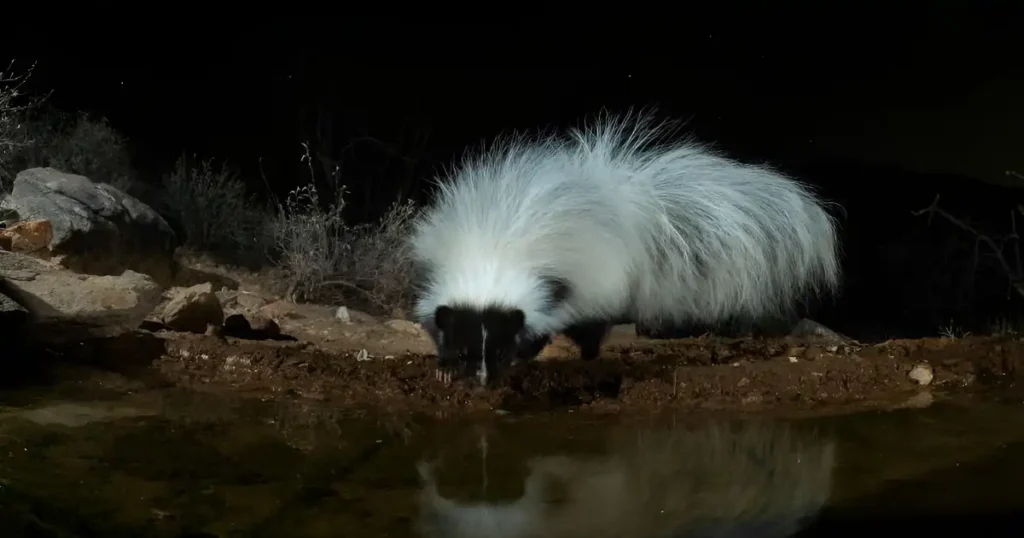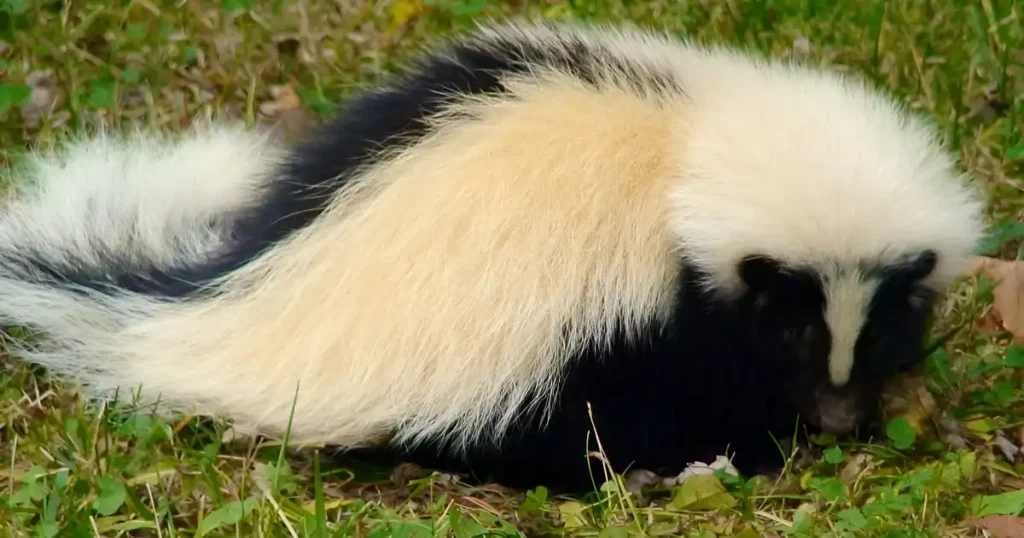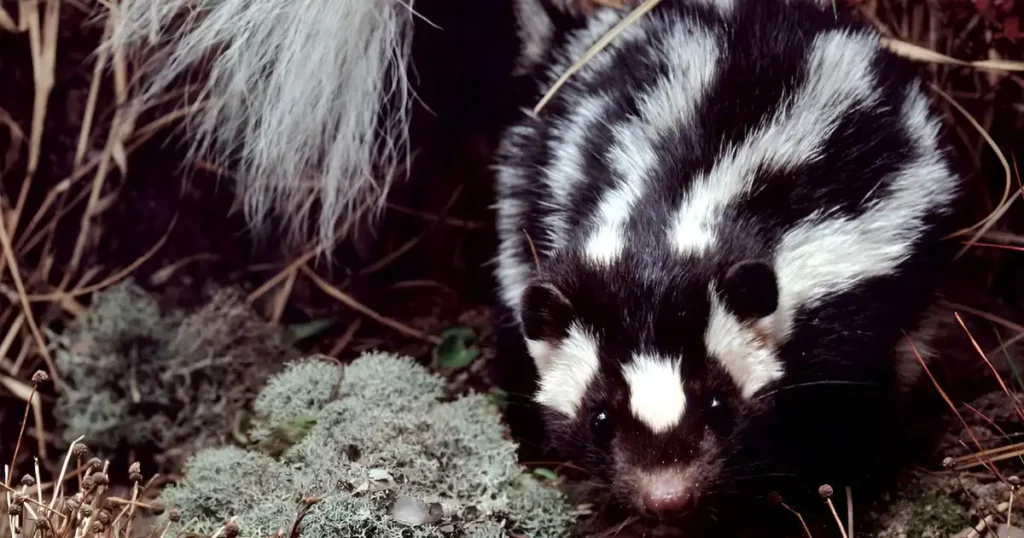
The hooded skunk, also known as the Mephitis macroura, is a small mammal that belongs to the skunk family. It is found in the southwestern United States, parts of Mexico, and Central America. The hooded skunk is known for its unique coloring, which includes a black body with a white stripe on its head that extends down its back. It also has a white tail with a black tip.
The hooded skunk is a nocturnal animal that feeds on insects, small mammals, and fruits. It is known for its defensive behavior of spraying a strong-smelling liquid from its anal glands when threatened. This liquid can cause temporary blindness and is difficult to remove from clothing and skin. Despite this, the hooded skunk is not considered a major threat to humans and is generally shy and non-aggressive.
The hooded skunk has been the subject of research due to its unique behavior and physical characteristics. Scientists have studied its diet, habitat, and mating habits to better understand this elusive animal. While the hooded skunk is not commonly seen in the wild, its distinct appearance and behavior make it a fascinating creature to learn about.
The hooded skunk, scientifically known as Mephitis macroura, is a medium-sized mammal that belongs to the family Mephitidae. It is characterized by its unique black and white markings, which are similar to those of a raccoon. The hooded skunk has a distinctive hood of black fur that extends from the back of its head to its shoulders, which it can raise when threatened.
Hooded skunks are typically 20-30 inches long and weigh between 2 and 4 pounds. They have short, stocky legs and a broad, bushy tail that is black with a white tip. Their fur is dense and soft, and their long, sharp claws are useful for digging.
Hooded skunks have a unique coloration that sets them apart from other skunk species. They are mostly black with a large white stripe that runs down their back and a smaller white stripe that runs down each side of their body. Some hooded skunks have additional white markings on their head, such as a white patch on their forehead or white around their eyes.
While most hooded skunks have the same basic coloration, there are some variations in their patterns and colors. Some hooded skunks are almost entirely black, with only a small amount of white on their head. Others are mostly white, with black markings on their back and sides. Thought to be genetic, these variations in color and pattern can vary between individuals and populations.
Overall, the hooded skunk has a distinctive appearance and interesting behaviors and is a fascinating and unique mammal.

The Hooded Skunk (Mephitis macroura) is a species of skunk native to North America. Its range extends from the southwestern United States to central Mexico. They are found in a variety of habitats, including deserts, grasslands, and forests.
Hooded Skunks are primarily found in northern Mexico, with their range extending into the United States. They are found in Arizona, New Mexico, Texas, and California. In Mexico, they are found in the states of Nuevo León, Baja California, San Luis Potosí, Sonora, Puebla, Tamaulipas, Chihuahua, Aguascalientes, Coahuila, Durango, Querétaro, Zacatecas, Jalisco, Guanajuato, Hidalgo, Mexico City, Morelos, and Veracruz.
These skunks are generally found in areas with rocky terrain and good cover, such as brushy areas, rocky outcroppings, and caves. They are also found in agricultural areas and suburban areas, where they can find food and shelter.
Overall, the Hooded Skunk has a fairly wide distribution but is not as common as other species of skunk. They are generally not considered to be a threatened species, but habitat loss and fragmentation can have an impact on their populations.
The hooded skunk is an omnivorous mammal that feeds on a variety of foods, including other animals like small mammals, insects, plant matter, and reptiles. They have an acute sense of smell and can detect food sources with ease. The skunk's diet varies depending on the season, with insects being a primary food source in the warmer months, while plant matter becomes more important in the cooler months.
Skunks are known for spraying a foul-smelling liquid as a defense mechanism, but they also have other adaptations that help them survive. For example, their strong front claws allow them to dig for insects and burrow into the ground for shelter. They also have a digestive system made for breaking down tough plant materials.
Hooded skunks are generally solitary animals, but they may form small groups during the mating season. Competitions for females among males are common, and fights between males can be intense. Skunks are primarily nocturnal and will spend their days sleeping in burrows or other sheltered areas.
Skunks are not typically aggressive towards humans, but they can become a nuisance when they take up residence in or around homes. It's important to take steps to prevent skunks from entering buildings and to avoid leaving out foods that may attract them.
Overall, the hooded skunk is a fascinating and adaptable animal that plays an important role in its ecosystem. By understanding their behavior and diet, we can better appreciate and coexist with these unique creatures.

Hooded skunks are polygamous, which means that one male mates with multiple females. Late winter to early spring is when their breeding season occurs. During this time, males will compete with each other to establish dominance and gain access to females. They will often fight, spray musk, and engage in other aggressive behaviors to assert their dominance.
Female hooded skunks have a gestation period of approximately 60 days. They give birth to litters of 2-6 offspring, which are called kits. The kits are dependent on their mother for protection and sustenance because they are blind and defenseless. For several weeks, they won’t be able to eat solid food, so the mother will nurse her kits during this time.
Male and female hooded skunks have similar lifespans, which typically range from 2-4 years in the wild.
Hooded skunks reach sexual maturity at around 8-10 months of age. At this point, males will begin to exhibit more aggressive behaviors as they compete for mates.
As the kits grow and develop, they become more independent and start to explore their surroundings. They will start to eat solid food and learn important survival skills from their mother. After several weeks, the kits will start to venture out of the den and explore the world on their own.
Overall, hooded skunks have a fascinating reproductive and developmental process. Their polygamous breeding patterns and aggressive behaviors during mating season make them an interesting species to study.
Male and female hooded skunks can be identified based on their physical characteristics. The main difference between the two sexes is their size. Larger than females, males will have an average weight of 3.9 to 4.8 pounds, while females weigh around 3 to 4.4 pounds.
Another way to distinguish between male and female skunks is by observing their stripes. Male skunks have wider and more prominent stripes than females, which are typically more narrow and less distinct. This is due to sexual dimorphism, where males have evolved to have more striking physical characteristics to attract mates.
In addition to size and stripes, male skunks also have longer and thicker tails compared to females. This is because the male's reproductive organs are located at the base of the tail, which requires more support.
These physical differences, however, may not always be apparent, especially in juvenile skunks or during certain times of the year. However, by observing these characteristics, one can accurately identify the sex of a hooded skunk.

The hooded skunk is currently listed as a species of least concern by the International Union for Conservation of Nature (IUCN). However, there are still some threats facing this species that could potentially impact its population in the future.
One of the main threats to them is habitat loss due to human activities such as deforestation and urbanization. As the natural habitats of these skunks are destroyed, their populations become more fragmented and isolated, making it harder for them to find mates and reproduce.
Another threat to the hooded skunk is hunting, both for sport and for its fur. While hunting of this species is illegal in many countries, it still occurs in some areas, putting additional pressure on the already vulnerable population.
Despite these threats, there are several measures in place to protect them. It is illegal, in many countries, to hunt or capture these animals, and efforts are being made to protect their natural habitats. Additionally, research is being conducted to better understand the biology and behavior of these skunks, which will help to inform conservation efforts in the future.
Overall, while the hooded skunk is not currently considered to be at high risk of extinction, conservation efforts and continued monitoring will be necessary to ensure that this unique species remains a part of our natural world.
The Hooded Skunk is one of the many species of skunks found in North and South America. It is often compared to the Striped Skunk due to their similar appearance, but there are some notable differences. They have a distinct hood of white fur on its head, while the Striped Skunk has a white stripe running down its back.
Another species that is often compared to the Hooded Skunk is the Spotted Skunk. The Spotted Skunk is smaller and has a more varied coat pattern, with spots and stripes covering its body. Unlike the Hooded Skunk, the Spotted Skunk is known for its ability to perform handstands when threatened. Other species include striped skunks, hog nosed skunks such as the american hog nosed skunk and the striped hog nosed skunk, and spotted skunks such as the western spotted skunk and the eastern spotted skunk.
While the Hooded Skunk has a unique appearance, other skunk varieties have special fur patterns as well. The Black Skunk, as its name suggests, has a completely black coat. This variety is not as common as the Striped or Hooded Skunks but can be found in some regions.
Reverse Color Skunks, on the other hand, have a white coat with black markings. This variety is also known as the Albino Skunk, but it is important to note that they are not true albinos as they still have some pigmentation in their eyes and skin.
Lastly, there is the Mostly White Skunk. As the name suggests, this variety has a mostly white coat with some black markings. The Mostly White Skunk is not a separate species, but rather a genetic variation of the Striped Skunk.
Overall, while there are many different skunk species and varieties, each one has its unique characteristics and appearance. To properly identify and appreciate these fascinating creatures, it is important to understand these differences.

Skunks are known for their distinctive odor and can be a nuisance to humans. However, skunks play an important role in the ecosystem by controlling insect and rodent populations. Skunk management is necessary to prevent conflicts with humans.
One way you can manage skunks is to eliminate potential food sources, such as garbage and pet food. Skunks are attracted to these food sources and may take up residence near human dwellings. Sealing up any openings in buildings and sheds can also prevent skunks from entering.
In cases where skunks become a problem, it is important to contact a professional wildlife removal service. Attempting to remove skunks on your own can be dangerous and may result in being sprayed with their noxious odor.
Some people may be interested in keeping skunks as pets. However, it is important to note that in many states, including Texas, it is illegal to keep skunks as pets. Skunks are also not domesticated animals and may exhibit unpredictable behavior.
Skunks also have specific environmental and dietary requirements that must be met to keep them healthy. They require a high-protein diet and a large enclosure with plenty of space to roam. Skunks also require regular veterinary care, including vaccinations.
In addition, skunks have scent glands that release their noxious odor when they feel threatened or frightened. This can be a serious concern for pet owners and their guests.
Overall, while skunks may seem like an interesting and unique pet, they are not suitable for most people and are best left in their natural habitat.
Hooded skunks can be fascinating and unique creatures, but they can also become a nuisance when they invade your home and try to make it theirs as well. If you want to get a hooded skunk, or any other species of skunk, out of your home, Critter Stop is your best bet! We service residential and commercial customers in Texas, have a five-star reputation, and offer industry-leading guarantees. Contact Us now at (214) 234-2616 and book a free inspection and estimate today!
What distinguishes a hooded skunk from a striped skunk?
Also known as the southern spotted skunk, is smaller than the striped skunk and has a unique white "hood" marking on its head. It also has smaller stripes on its back and a bushier tail
What is the typical size of a hooded skunk?
Hooded skunks are relatively small, with adults typically weighing between 1.5 and 3 pounds and measuring 12 to 20 inches in length.
What does a hooded skunk's diet consist of?
Hooded skunks are omnivores and their diet includes insects, small mammals, reptiles, fruits, and vegetables.
In which regions can hooded skunks be commonly found?
Hooded skunks are primarily found in the southwestern United States, Mexico, and Central America. They prefer habitats such as grasslands, woodlands, and deserts.
What are the primary predators of hooded skunks?
The primary predators of hooded skunks are larger carnivores such as coyotes, foxes, and birds of prey. Habitat destruction and roadkill are also threats they face.
How does the hooded skunk's defense mechanism work?
Like other skunks, they have a potent defense mechanism that involves spraying a foul-smelling liquid from its anal glands. However, unlike other skunks, they are also capable of performing handstands and spraying its attacker with the liquid while standing on its front paws. The reason for this behavior is thought to be the decrease of predators’ chances to attack the skunk's vulnerable underside.
Visit our Critter Library and learn more about our furry friends